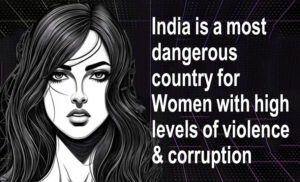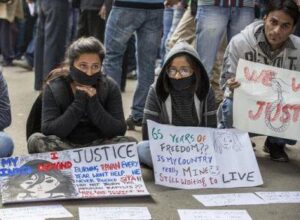
Reported by Suprovat Sydney: India is often viewed as a perilous country for women and plagued by corruption. A Times of India poll conducted on May 7, 2002, revealed that corruption is regarded as the nation’s most critical issue “the number one problem.”
After fifty-five years of independence and fifty-three years under the Constitution, a common experience unites Indian citizens: accessing public services often requires paying bribes or leveraging connections through VIP recommendations. N. Vittal, a prominent anti-corruption advocate, emphasizes this troubling reality, describing corruption as “by far the biggest challenge to the growth of our society and nation.”

With his extensive experience as the Central Vigilance Commissioner (CVC), Vittal offers a unique perspective, viewing the issue through a broad lens. He remains hopeful, asserting that while corruption is a daunting challenge, it can indeed be addressed through concerted efforts.
Corruption in India significantly impacts the economy at the central, state, and local government levels, hindering overall growth. A study by Transparency International in 2005 revealed that over 62% of Indians had, at some point, paid a bribe to a public official to obtain necessary services. By 2008, another report indicated that nearly 50% of Indians had firsthand experience with bribery or used connections to facilitate interactions with public offices.

In Transparency International’s 2023 Corruption Perceptions Index, which evaluates 180 countries on a scale from 0 (highly corrupt) to 100 (very clean), India scored just 39. This placed the country 93rd in the rankings, where the top spot is held by the nation with the most transparent public sector. For context, the highest score was 90 (ranked 1), the lowest score was 11 (ranked 180), and the global average was 43. In the Asia-Pacific region, the highest score was 85, the lowest was 17, and the average stood at 45.
Several factors contribute to this pervasive corruption, including officials embezzling funds from government social welfare programs like the Mahatma Gandhi National Rural Employment Guarantee Act and the National Rural Health Mission. Additionally, India’s trucking industry bears a heavy burden, forced to pay billions in bribes annually at numerous regulatory and police checkpoints along interstate highways.

The media has extensively reported allegations of corrupt Indian citizens hiding millions of rupees in Swiss banks. While Swiss authorities initially denied these claims, subsequent investigations conducted in 2015–2016 substantiated the allegations. In July 2021, India’s Central Board of Direct Taxes (CBDT) responded to Right to Information (RTI) requests, revealing the identification of undeclared assets totaling Rs 20,078 crore, discovered both domestically and internationally through investigations up to June 2021.

Several factors contribute to corruption in India, including excessive regulations, convoluted tax and licensing systems, and a multitude of government departments characterized by opaque bureaucracies and discretionary powers. The monopoly of government-controlled institutions over the delivery of certain goods and services further exacerbates the problem. Additionally, a lack of transparent laws and processes allows corruption to flourish. There are also significant disparities in the levels of corruption and the effectiveness of government efforts to combat it across different regions of India.
Given the pervasive and damaging nature of corruption, which impacts all facets of Indian society and the economy, the Indian government has made concerted efforts to combat this issue. A significant initiative began in 1963, when the Nehru administration established the Santhanam Committee in response to the Mundhra Corruption Scandal. This committee meticulously identified key sources of corruption within the state, highlighting problems such as red tape and excessive administrative control.
One of the committee’s notable achievements was the creation of the Central Vigilance Commission, which serves as the country’s primary anti-corruption body. Additionally, in 1971, the government established the Comptroller and Auditor General of India to oversee the public finances of key institutions and curb corrupt practices.

At the state level, Lokayuktas—civil commissioners tasked with addressing corruption—were introduced, with the first office established in 1966. Since then, several Indian states have established their own Lokayuktas. A prominent example is Karnataka, where in 2011, the Karnataka Lokayukta indicted then-Chief Minister B.S. Yeddyurappa for illegal mining activities, ultimately leading to his resignation.
Corruption can drive individuals to commit crimes at every level of society, both locally and globally. Many Indians engage in corrupt practices even when they travel abroad, often unaware that their actions can tarnish their country’s reputation.
A recent investigation has linked an Indian émigré in Norway to the deadly pager blasts targeting Hezbollah operatives, which killed 12 people and injured thousands in Lebanon. Rinson Jose, originally from Wayanad in Kerala, reportedly owned a company in Bulgaria implicated in supplying pagers to the militant group. Jose moved to Norway a few years ago for higher studies and briefly worked in London before settling in Oslo.
In Canada, around 700 Indian international students face potential deportation due to a scam involving fraudulent acceptance letters to educational institutions. These students find themselves in a precarious situation as they await assessments from Immigration, Refugees and Citizenship Canada (IRCC). This widespread fraud has persisted for years, underscoring the vulnerabilities faced by international students.

Additionally, Canadian Prime Minister Justin Trudeau’s recent return from India in September 2023, following the G20 Summit, sparked controversy with allegations of India’s involvement in the killing of Khalistani extremist Harminder Singh Nijjar, a Canadian citizen, in June.
In India’s northeastern state of Manipur, ethnic conflict between the Kuki and Meitei groups has led to severe human rights abuses. Reports indicate that between May 3 and November 15, at least 175 people were killed, and over 60,000 were displaced. Activists and journalists have documented armed clashes, sexual violence, and the destruction of homes and places of worship. In response, the government deployed security forces, imposed daily curfews, and enacted internet shutdowns. The Supreme Court criticized both the central and Manipur state governments for their failure to contain the violence and appointed officials to investigate the incidents, ensure the delivery of humanitarian aid, and facilitate the rebuilding of damaged properties.
The Australian federal government has imposed a cap on international student enrolments and raised English proficiency requirements to curb net migration and combat fraud in the education sector.
In northern India, police in Chandigarh estimate that nearly 400 families have fallen victim to visa fraud schemes. The registration for the Willows Institute, one of the colleges that attracted Indian students, was cancelled in June 2024 due to these issues.

An Australian company owned by the Gupta family, of Indian origin, is currently under investigation by both the Australian Federal Police and India’s Central Board of Direct Taxes.
In response to rising concerns about visa fraud, universities in Victoria and New South Wales have placed restrictions on recruiting students from certain Indian states. Outgoing Australian High Commissioner Barry O’Farrell praised the Indian diaspora but expressed concern over incidents of vandalism at temples.
Education agents in India who represent Australian universities have criticized these temporary bans, arguing that they unfairly discriminate against applicants from specific states and could deter genuine students seeking education opportunities.
According to a report by Transparency International India (TII), at least 30% of 2,742 business executives surveyed globally consider Indians among the most corrupt when conducting business abroad to “speed things up.”
In conclusion, while corruption remains deeply entrenched in India, the country’s anti-corruption measures are often half-hearted and sluggish. This is primarily due to vital institutions designed to combat graft lacking genuine autonomy and a strong sense of purpose. Even those anti-corruption bodies with some degree of independence, such as the Central Vigilance Commission (CVC) and Lokpal, have not demonstrated true effectiveness.

It is important to recognize that the fight against entrenched corruption cannot be left solely to these elite institutions. While high-level corruption tends to attract media attention and occasional national outrage, much of the corruption that affects ordinary citizens occurs at the grassroots level. The CVC addresses complaints involving lower-level officials, but in practical terms, it often operates as a toothless entity. The most significant progress in reducing lower-level corruption has come from the increasing digitization of services; however, technology alone cannot eradicate this complex issue, which resembles a hydra-headed monster.
Under the Right to Information (RTI) Act, government authorities are legally obligated to respond to requests for information about their activities, making the RTI Act a crucial tool against corruption.
Fighting corruption necessitates bold structural reforms and a comprehensive refinement of existing laws. Urgent repairs to India’s broken criminal justice system are essential, as its inefficiencies—where cases can take years or even decades to resolve—foster impunity and perpetuate corrupt behavior. Additionally, many instances of corruption and kickbacks are linked to opaque political funding, particularly the current practice of allowing electoral bonds without transparency. Without significant reforms in campaign finance—especially regarding transparency, disclosure, and accountability—it will be impossible to eliminate corruption at its roots within key sectors of the economy and society.
As India seeks to position itself as a responsible global actor, it is imperative for political leadership to implement comprehensive reforms, including transparency in political funding, overhauling the justice delivery system, and upholding the integrity of the RTI process to effectively tackle corruption.
In related news, India has been exporting rockets and explosives to Israel amid the ongoing Gaza conflict. On June 6, 2024, following Israel’s bombing of a United Nations shelter in the Nuseirat refugee camp, the Quds News Network released a video showcasing remnants of a missile dropped by Israeli warplanes, with a label clearly reading: “Made in India.”
India faces numerous internal and external challenges daily, rooted in issues of integrity, racism, loyalty, and corruption. Recently, the Supreme Court of India announced that it will oversee all cases of violence against women arising from the three months of sectarian clashes in the northeastern state of Manipur, which began in May.
The conflict originates from tensions between Manipur’s Meitei majority and the Kuki-Zo, one of several tribal groups comprising about 16% of the state’s population. The Meitei are predominantly Hindu and primarily reside in the capital, Imphal, and the surrounding prosperous valley. In contrast, the mostly Christian Kuki-Zo inhabit scattered settlements in the hills.

Human Rights Watch has accused the state authorities in Manipur, led by Modi’s Bharatiya Janata Party (BJP), of exacerbating the conflict through “divisive policies that promote Hindu majoritarianism.”
“There is no value for women in India,” stated Deepa Narayan in The Guardian. A global survey reveals a troubling cultural consensus that devalues women in our society, positioning India as the most dangerous country for women.
The Thomson Reuters Foundation has ranked India as the world’s most perilous place for women, surpassing even Afghanistan, Syria, and Saudi Arabia. This survey’s significant contribution lies in reframing the conversation around the gender gap and gender equality into a critical discussion about women’s safety and the inherent dangers they face.
Despite the evidence, India remains in denial about the widespread fear that women experience in various settings—whether on the streets, at work, in markets, or even at home. Many women have learned to navigate this pervasive anxiety, but the underlying issues remain unaddressed. While international human rights organizations are working tirelessly to improve the situation, there is an urgent need to challenge and change the deeply ingrained attitudes that perpetuate this culture of corruption and violence against women.